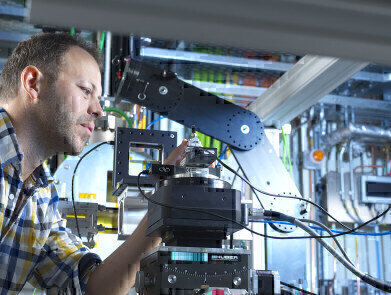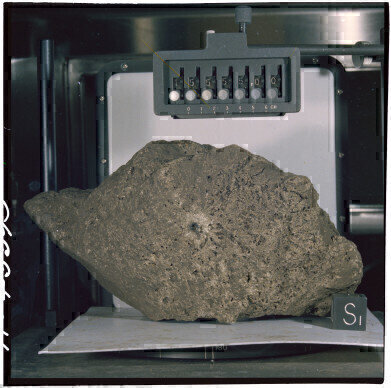-
 Moon rocks under study at Diamond Light Source
Moon rocks under study at Diamond Light Source -

News & Views
Lighting up Moon Rocks from the Apollo Missions
Oct 16 2018
An international collaboration involving scientists in Tenerife, the US and the UK, are using Diamond Light Source to investigate Moon rocks recovered during the Apollo Missions in a brand new way.
Dr. Matt Pankhurst of Instituto Volcanológico de Canarias and NASA lunar principle investigator explains; “We have used a new imaging technique developed at Diamond to carry out 3D mapping of olivine – a common green mineral found in the Earth’s sub-surface and in these Moon rock samples. These maps will be used to improve understanding of the Moon’s ancient volcanic systems and help to understand active geological processes here on Earth.
“With this new technique, our team may be able to recover from these Moon rock samples information such as what the patterns of magma flow within the volcanic system were, what the magma storage duration was like and potentially even identify eruption triggers. The data will be analysed using state-of-the-art diffusion modelling which will establish the history of individual crystals.”
The team have examined samples from the Apollo 12 and 15 missions, using an advanced X-ray speckle imaging technique developed on Beamline B16 at Diamond Light Source that does not damage the samples. As Dr. Hongchang Wang, Senior Optics Scientist, explains: “Combined with the recently developed fast fly-scan tomography and novel white beam camera, the X-ray speckle imaging technique has allowed us to swiftly and effectively collect 3D information of olivine inside of the lunar rock in much more detail than ever before.”
In magma, the ratio of iron to magnesium in olivine changes over timeframes ranging from hours to months, and these changes are ‘locked in’ to the mineral as the magma cools. Accurate 3D images of the iron distribution within olivine in the Moon rock samples will ‘unlock’ information about the volcanic processes in which they formed.
NASA approved the use of 18 lunar samples for these experiments and similar, well-characterised terrestrial samples have also been scanned and used to verify the chemical composition of olivine. Samples are loaned to scientists who wish to study them, a process overseen by NASA's Apollo sample curator, Ryan Zeigler. As a scientist who understands the trade-off between studying the samples and preserving them, a balance must be struck in experiment design. These decisions are becoming easier as more powerful, non-destructive techniques become available. “The researchers are now using state-of-the-art diffusion modelling to establish the history of individual crystals of olivine from 3D images. These techniques will be applied to the new data gathered during this beamtime. The results will add to our understanding of lunar and planetary formation, topics which have been continually debated since the samples were first returned to Earth,” Dr Zeigler said.
Prof Andrew Harrison CEO at Diamond Light Source concluded “A successful demonstration of the new technique at B16 will pave the way, we hope, for extended collaboration with NASA and maybe next No10* Downing Street and the Natural History Museum might be interested in loaning us their own samples.
*The UK’s Moon rock gift was presented to Prime Minister Harold Wilson by President Richard Nixon in 1970 and are currently on display in Downing Street and The natural History Museum.
Digital Edition
Lab Asia 31.2 April 2024
April 2024
In This Edition Chromatography Articles - Approaches to troubleshooting an SPE method for the analysis of oligonucleotides (pt i) - High-precision liquid flow processes demand full fluidic c...
View all digital editions
Events
Apr 22 2024 Marrakech, Morroco
Making Pharmaceuticals Exhibition & Conference
Apr 23 2024 Coventry, UK
Apr 23 2024 Kintex, South Korea
Apr 23 2024 Seoul, South Korea
Apr 24 2024 Jakarta, Indonesia



.jpg)













